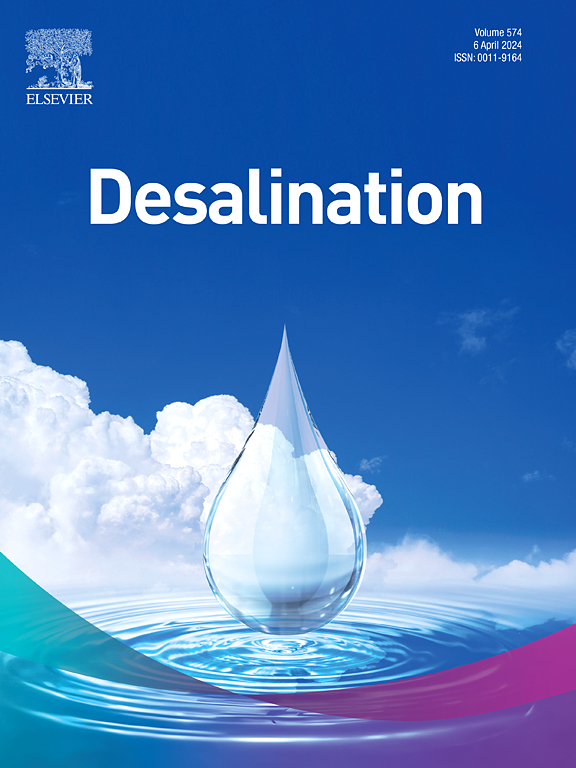Durable TiO2@Cu-alginate hydrogel membrane with rapid in-situ cleaning for high-performance dye desalination applications
IF 8.3
1区 工程技术
Q1 ENGINEERING, CHEMICAL
引用次数: 0
Abstract
Nanofiltration (NF) membrane filtration has garnered significant attention for the desalination of high-value-added molecules due to its exceptional selective separation performance. In this study, CuCaAlg/TiO2 membranes were synthesized by physically incorporating nanoparticles into the natural alginate polymer network through dual cross-linking. The synthesis process was rapid, straightforward, and environmentally friendly, with no organic waste discharge. The interaction between rigid inorganic nanofillers and polymer networks not only enhances the mechanical strength of the hydrogel but also modulates the degree of topological defects within the membrane structure. This modulation facilitates overcoming the selective separation-permeation trade-off effect in the separation process. The resulting membrane exhibited outstanding dye/salt separation performance, including high permeability and efficient dye/salt selectivity separation. Additionally, the membrane demonstrated excellent hydrophilicity, swelling resistance, and anti-fouling properties. Furthermore, combined with a simple cleaning strategy (UV-H2O2-cross flow filtration), this composite functional membrane enabled rapid in-situ cleaning in high-concentration dye application scenarios. Such cleaning procedures contribute to maintaining the stability of the hydrogel membrane during dye desalination and separation applications. We anticipate that this composite membrane holds great promise for resource treatment of dye wastewater across various scenarios.
耐用TiO2@Cu-alginate水凝胶膜与快速原位清洗高性能染料脱盐应用
纳滤膜因其优异的选择性分离性能,在高附加值分子的脱盐中得到了广泛的关注。在本研究中,通过双交联将纳米颗粒物理结合到天然海藻酸盐聚合物网络中,合成了CuCaAlg/TiO2膜。合成过程快速、简单、环保,无有机废物排放。刚性无机纳米填料与聚合物网络之间的相互作用不仅提高了水凝胶的机械强度,而且调节了膜结构内拓扑缺陷的程度。这种调制有助于克服分离过程中的选择性分离-渗透权衡效应。所制备的膜具有优异的染料/盐分离性能,包括高渗透性和高效的染料/盐选择性分离。此外,该膜还具有优异的亲水性、抗膨胀性和抗污染性能。此外,结合一种简单的清洗策略(uv - h2o2 -交叉流过滤),这种复合功能膜可以在高浓度染料应用场景中实现快速的原位清洗。这种清洗程序有助于在染料脱盐和分离应用中保持水凝胶膜的稳定性。我们预计这种复合膜在各种情况下对染料废水的资源化处理具有很大的前景。
本文章由计算机程序翻译,如有差异,请以英文原文为准。
求助全文
约1分钟内获得全文
求助全文
来源期刊

Desalination
工程技术-工程:化工
CiteScore
14.60
自引率
20.20%
发文量
619
审稿时长
41 days
期刊介绍:
Desalination is a scholarly journal that focuses on the field of desalination materials, processes, and associated technologies. It encompasses a wide range of disciplines and aims to publish exceptional papers in this area.
The journal invites submissions that explicitly revolve around water desalting and its applications to various sources such as seawater, groundwater, and wastewater. It particularly encourages research on diverse desalination methods including thermal, membrane, sorption, and hybrid processes.
By providing a platform for innovative studies, Desalination aims to advance the understanding and development of desalination technologies, promoting sustainable solutions for water scarcity challenges.
 求助内容:
求助内容: 应助结果提醒方式:
应助结果提醒方式:


